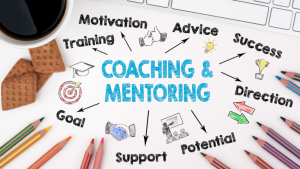
Good leaders ask open-ended questions. Then, they listen to the responses and use the feedback proactively! This leadership skill is critical to unleashing your team’s power and generating the solutions needed to resolve problems.
In my recent article, How to Ask the Right Questions to Achieve Results, I outlined how to ask questions. In this article, we’re focusing on encouraging conversations and discussions by asking open-ended questions.
We’re not wired to ask open-ended questions, and this limits our results. When you use open-ended questions and have at least three questions ready to keep your team talking, it’s amazing what you can learn and the new ideas that are generated, especially when the team or conversation is stuck (e.g., circular logic, same-old excuses, stories, and ideas).
(Hint to get started: Create a “cheat sheet” by writing down the open-ended questions listed below. Keep this with you for every phone call, sales call, interview, etc. As you start conversations, pay attention to whether or not you’re using an open-ended question. If you’re not using open-ended questions, a lot of information, insights, and sales opportunities will be left undiscovered. Remember, like any new skill, this takes practice!)
If you’re not asking open-ended questions, you’re limiting solutions, new ideas, and resolving issues because when employees feel valued and heard, they work harder to get problems resolved and are willing to talk out ideas!
What are open-ended questions?
- Cannot be answered with a yes or no
- Cannot be answered with one-word responses
- Do not have pre-defined answers
- Allows team members to provide insights that have not been considered
- Promotes in-depth discussions
- Energizes conversations and meetings
Incorporating open-ended questions allows your team members and others to elaborate and share their ideas, thoughts, and feelings.
How to begin asking open-ended questions:
Start with: Who, What, When, Where, Why, and How type questions. Using these words at the beginning of a question will open up opportunities for others to respond.
Examples:
- Who should be involved and why?
- What are the hidden costs of this idea?
- When is a good time to start, and why?
- Where are good places to host this event?
- Why is this important?
- How do you propose we move forward?
This method works well during brainstorming, offering feedback, job interviews, or generating new ideas when the team is stuck.
Other ways to start open-ended questions:
- Tell me about …
- Please describe …
Where you can use open-ended questions (remember to listen):
Hint: You can use them EVERYWHERE!
More specifically:
- Job Interviews: Asking open-ended questions during job interviews can give you insights into candidates’ skills and personalities.
- Meetings to Debrief or Provide Feedback: Participants feel more open to providing important information when open-ended questions are asked.
- Social Get-Togethers: When meeting others, ask open-ended questions to begin a conversation. “Why do you enjoy this xxx?”
- Networking Events: Asking open-ended questions encourages others to share their experiences, interests, and other tidbits of information. “What brought you to this event?” (Works exceptionally well if you are an introvert or talking with a shy person.)
- Sales Calls: Going beyond the yes or no responses, you can uncover the hidden elements needed to help the client and close the deal.
- Brainstorming or Idea Generating Sessions: Open-ended questions open opinions, thoughts, and other creative gems.
- Resolving Team Conflicts: These can be tricky. It’s important to be non-accusatory and listen critically. First, ask: “Tell me about what you believe is the #1 issue.” Then, ask, “Why is this important?” (Note: Be responsible for using “why” to begin the conversation, and use it after they’ve shared their concerns.)
Remember, asking open-ended questions invites better conversations and provides more fulfilling interactions. So, go ahead and embrace the art of asking open-ended questions! What would you have to lose?
©Jeannette Seibly 2024 All Rights Reserved
 Jeannette Seibly is a Talent Advisor/Leadership Results Coach with over 31 years of experience guiding leaders and bosses to improve their hiring, coaching, and managing practices and produce amazing results! And yes, achieving business success always starts with having the right people in the right jobs! She has been an Authorized PXT Select Partner for over 31 years. Contact Jeannette to learn more about this state-of-the-art job-fit assessment tool or how to coach and manage your people to achieve extraordinary results.
Jeannette Seibly is a Talent Advisor/Leadership Results Coach with over 31 years of experience guiding leaders and bosses to improve their hiring, coaching, and managing practices and produce amazing results! And yes, achieving business success always starts with having the right people in the right jobs! She has been an Authorized PXT Select Partner for over 31 years. Contact Jeannette to learn more about this state-of-the-art job-fit assessment tool or how to coach and manage your people to achieve extraordinary results.
A note from Jeannette: Asking open-ended questions is a skill most bosses and leaders need to use. Why? It takes time. Yet, the truth is … it takes less time to find out now (aka pay now or pay later). Want to become an influential boss or leader? Get on the fast track by tapping into my 31++ years of experience in developing them! Contact me now with your questions!
 What could you accomplish by unleashing your inner leader now? Are there days you dread managing people, projects, and your team’s financial performance? You’re not alone! Everyone has their blind spots! NOW is the time to get the guidance you need to make the right changes for 2024. I have extensive experience and wisdom guiding bosses and leaders to hire, coach, and manage their teams successfully. The bonus is that they achieve unprecedented results. Contact me to learn more about my in-depth, one-on-one, customized coaching programs.
What could you accomplish by unleashing your inner leader now? Are there days you dread managing people, projects, and your team’s financial performance? You’re not alone! Everyone has their blind spots! NOW is the time to get the guidance you need to make the right changes for 2024. I have extensive experience and wisdom guiding bosses and leaders to hire, coach, and manage their teams successfully. The bonus is that they achieve unprecedented results. Contact me to learn more about my in-depth, one-on-one, customized coaching programs.


 Jeannette Seibly is a champion for bosses and teams delivering intended results. Does your company or department have a persistent problem? Her wisdom guides clients through sticky situations and challenging relationships for dynamic results!
Jeannette Seibly is a champion for bosses and teams delivering intended results. Does your company or department have a persistent problem? Her wisdom guides clients through sticky situations and challenging relationships for dynamic results!  Have you considered the benefits of strengthening your superpowers and becoming a great boss? It’s not complicated, but it does require an experienced sounding board. I have extensive experience guiding bosses and leaders to work with and through their teams to achieve unprecedented results.
Have you considered the benefits of strengthening your superpowers and becoming a great boss? It’s not complicated, but it does require an experienced sounding board. I have extensive experience guiding bosses and leaders to work with and through their teams to achieve unprecedented results. 
 Jeannette Seibly is The Leadership Results Coach. She is an award-winning international executive coach, speaker, and business author. Her wisdom of over 30 years guides clients to work through sticky situations and challenging relationships.
Jeannette Seibly is The Leadership Results Coach. She is an award-winning international executive coach, speaker, and business author. Her wisdom of over 30 years guides clients to work through sticky situations and challenging relationships.  Have you considered the benefits of strengthening your superpowers and becoming a great boss? It’s not complicated, but it does require an experienced sounding board. I have extensive experience guiding bosses and leaders to work with and through their teams to achieve unprecedented results.
Have you considered the benefits of strengthening your superpowers and becoming a great boss? It’s not complicated, but it does require an experienced sounding board. I have extensive experience guiding bosses and leaders to work with and through their teams to achieve unprecedented results. 
 Are you frustrated because you are a results producer and now not producing the intended results? It’s time to find out “why” and get back into the game. It requires seeing your blind spots and hiring a coach! I have extensive experience guiding bosses and leaders to work with and through their teams to achieve unprecedented results.
Are you frustrated because you are a results producer and now not producing the intended results? It’s time to find out “why” and get back into the game. It requires seeing your blind spots and hiring a coach! I have extensive experience guiding bosses and leaders to work with and through their teams to achieve unprecedented results. 
 Have you considered the benefits of strengthening your superpowers and becoming a great boss? It’s not complicated, but it does require an experienced sounding board. I have extensive experience guiding bosses and leaders to work with and through their teams to achieve unprecedented results.
Have you considered the benefits of strengthening your superpowers and becoming a great boss? It’s not complicated, but it does require an experienced sounding board. I have extensive experience guiding bosses and leaders to work with and through their teams to achieve unprecedented results. 
 Ask your employees to share their ideas! This is a superpower that many leaders fail to develop! Then, they experience turnover, shaky bottom lines, and loss of customers. Working with and through others builds confidence and the ability to influence!
Ask your employees to share their ideas! This is a superpower that many leaders fail to develop! Then, they experience turnover, shaky bottom lines, and loss of customers. Working with and through others builds confidence and the ability to influence! 
 Taking the safe path to avoid uncertainty will never work in your business, career, and life. Develop your superpower and learn how to work through uncertainty. It builds confidence and the ability to influence others!
Taking the safe path to avoid uncertainty will never work in your business, career, and life. Develop your superpower and learn how to work through uncertainty. It builds confidence and the ability to influence others! 
 When you feel like quietly quitting your job, stop! Working through sticky situations and complex relationships isn’t hard if you understand “why!” Your mindset impacts your resilience and ability to achieve intended results! Stop waiting and hoping things will change! It won’t get easier if you wait!
When you feel like quietly quitting your job, stop! Working through sticky situations and complex relationships isn’t hard if you understand “why!” Your mindset impacts your resilience and ability to achieve intended results! Stop waiting and hoping things will change! It won’t get easier if you wait! 
 Have you met a challenge you’ve not been able to work through? Many managers and directors have, and their bosses may not be of much help. Now’s the time to develop your resilience and ability to achieve intended results! Waiting will not make a positive difference.
Have you met a challenge you’ve not been able to work through? Many managers and directors have, and their bosses may not be of much help. Now’s the time to develop your resilience and ability to achieve intended results! Waiting will not make a positive difference. 
 How’s your leadership development progressing? Are you moving forward … or a tad stuck? Do you need a “nudge” or “kick-in-the-butt?” Want to accelerate and soar your results?
How’s your leadership development progressing? Are you moving forward … or a tad stuck? Do you need a “nudge” or “kick-in-the-butt?” Want to accelerate and soar your results?